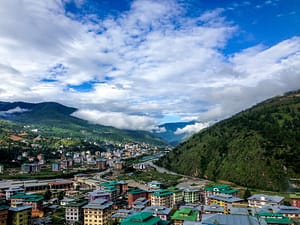Road Transport
Because Bhutan does not have a centimetre of passenger railway track, the only way to see the country is either by foot or by road, or the rather limited domestic air service, which is restricted to Paro, Bumthang and Gelephu at the time of research.
There is one main road: the National Highway, a stretch of tarmac that winds its way up and down mountains, across clattering bridges, along the side of cliffs and over high mountain passes. At the time of research the National Highway was in the process of being widened to double lanes. Until you experience the mountain roads of Bhutan you may not be able to fully appreciate the immensity of this undertaking. Nevertheless, rivers, mudflows and rockfalls present continual hazards, especially when it rains – and this won’t change with the new wider road. Roads can easily become blocked due to snow or landslides and can take anywhere from an hour to several days to clear. Take plenty of reading material.
If you are travelling on a tourist visa, the cost of all transport is included in the price of your trip and you’ll have a vehicle available for both short- and long-distance travel.
Air
Bhutan has limited domestic air services. Airports have been developed in Yongphula (south of Trashigang in the far east), Gelephu (in southern Bhutan, near the border with India) and Bathpalathang/Jakar (Bumthang, central Bhutan). At the time of writing, only Druk Air had scheduled domestic flights from Paro to Bathpalathang (via Gelephu fortnightly).
The Royal Bhutan Helicopter Service operates charter flights, sightseeing and medical evacuations from its base in Paro.
Bicycle
Some travellers bring their mountain bikes to Bhutan, and several companies can help arrange this kind of tour.
Bus
Only locals, residents and budget Indian tourists are likely to travel on buses. Public buses are crowded and rattly, and Bhutan’s winding roads make them doubly uncomfortable. The government’s Bhutan Post Express and other companies’ minibuses have earned the nickname ‘vomit comets’ as so many passengers suffer from motion sickness when travelling in them. Private operators such as Dhug, Metho and Sernya use more comfortable Toyota Coasters that cost about 50% more than the minibus fare.
Buses run at least once daily from Thimphu to Phuentsholing, Haa, Paro and Punakha. Long-distance buses run between one and three times weekly from Thimphu to Zhemgang, Samtse, Trashi Yangtse, Mongar, Phobjika and Trashigang. Fares are cheap.
Car & Motorcycle
Since all transport is provided by tour operators, you normally do not have to concern yourself with driving. If for some reason you are arranging your own transport, you are still far better off using the services of a hired car and driver or a taxi. Driving in Bhutan is a harrowing experience. Roads are narrow and trucks roar around hairpin bends, appearing suddenly and forcing oncoming vehicles to the side. Motorcycle trips in Bhutan can be arranged through Himalayan Roadrunners and Saffron Road Motorcycle Tours. The local company Knight Adventure Tours can organise motorcycle tours.
Your Own Vehicle
If you drive a vehicle into Bhutan, you can get a 14-day permit at the Phuentsholing border. You will need the help of a tour operator to handle the paperwork. If you are driving a vehicle that is registered overseas, you will need a carnet in order to get through India.
Indian visitors may travel throughout most of Bhutan in their own vehicle, upon getting all relevant documents such as registration papers, insurance policies, emission and fitness certificates and individual driving licences endorsed by the Road Safety and Transport Authority at the border. Traffic regulations are the same as in India and are strictly enforced.
Driving Licence
NGO staff and volunteers who insist on driving in Bhutan should obtain a driving licence issued by the Road Safety and Transport Authority. Bhutanese licences are also valid throughout India.
An International Driving Permit is not valid in Bhutan. An Indian driving licence is valid in Bhutan, and it’s possible for Indian nationals to drive in Bhutan; but unless you are an accomplished rally driver or are from a hill station such as Darjeeling and have experience in motoring in the mountains, it’s safer with a professional driver.
Taxi
There are taxis in Phuentsholing, Paro, Jakar and Thimphu. Taxis may have meters, but drivers rarely use them. For long-distance trips they operate on a flat rate that is rarely open to negotiation. Taxi drivers have a habit of charging foreigners, including Indians, as much as they can – one of Bhutan’s few rip-offs.

